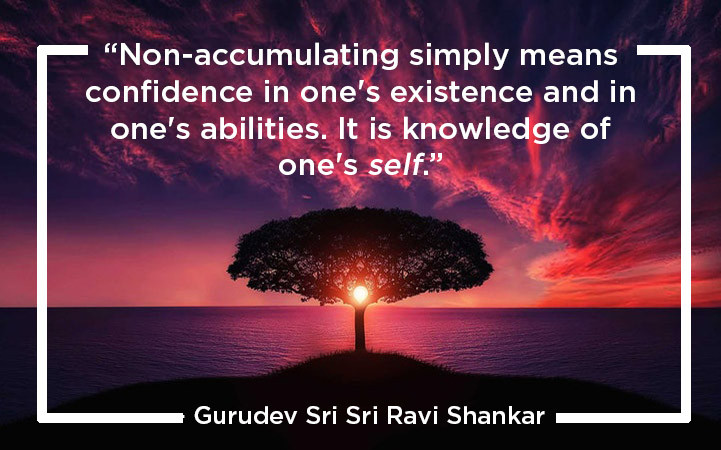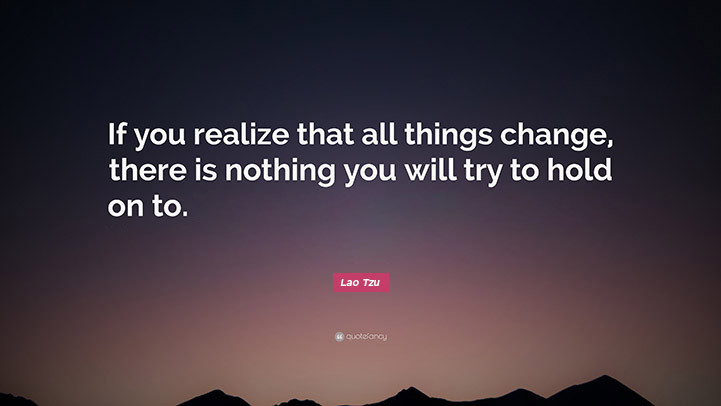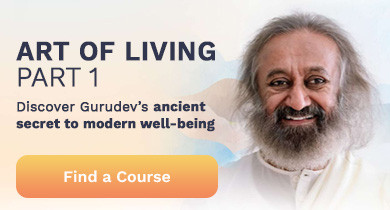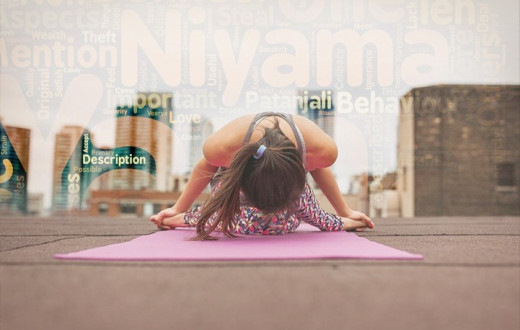By Sejal Shah | Updated on : December 10, 2020
Aparigraha, the 5th Yama of non-attachment, despite the implications, is not as scary as it might seem! Here’s how you can practice it in your life.
In this entry in our series on understanding Maharishi Patanjali’s Yamas and Niyamas, we’ll explore the 5th Yama of Aparigraha (non-accumulation and non-attachment), the dedicated practice of which can bring enormous freedom, self-reliance, and contentment in one’s life.
What is aparigraha?
Aparigraha is freedom from greed, possessiveness, or covetousness. To define and understand the literal meaning of aparigraha, let’s break down its three components: the first is “graha”, which means to reach for, accept, seek, or crave; the second is “pari”, which means from all sides; and lastly there is “a”, which is used for negation and means “non”. Combining the three, the word aparigraha means not taking more than is needed, practicing non-acceptance (including gifts), and non-accumulation--all of which, when practiced together, can help in developing an attitude of detachment or non-dependence, trust, and self-reliance.
The virtue of aparigraha helps us learn to take only what is truly necessary and no more. One should not try to keep or try to possess anything beyond the very necessities of life, or that which is required immediately.
Benefits of practicing aparigraha
1. Access to the higher knowledge of life
According to Maharishi Patanjali,
"Aparigraha sthairye janmakathamta sambodhaha'' (Yoga Sutra II. 39)
Aparigraha = non-accumulation; Sthairye = established; Janmakathamta = of how births happen; Sambhodhaha = knowledge.
"Being established in non-accumulation gives knowledge of how births happen."
When the yogi no longer desires to have possessions, he frees himself from the material world. This gives him a perspective of the purpose of his birth, both in this life and in past ones. He gains comprehension of the law of Karma and understands what lessons remain to be learned before attaining Realization. Patanjali says that “when aparigraha is established, one gets the awareness of past life events”. – Commentary from Swami Sivananda
He explains further, “Attachment, and the anxiety which accompanies attachment, are obstacles to knowledge. Freedom from attachment will result in knowledge of the whole course of our journey. Who was I? How was I? What is this? What shall I be? How shall I be? In this shape comes to him the knowledge of his own experience in the past, present, and future. He becomes independent and free. His mind becomes pure. Everything becomes quite clear to him. He gets a memory of past life also.”
2. Self-reliance

Non-accumulation and non-attachment can simply mean that you don’t depend on someone or something external for your own happiness and stability.
“When I let go of what I am, I become what I might be. When I let go of who I am, I receive what I need.” This insightful quote by Lao Tzu explains the whole essence of aparigraha beautifully.
“The yogi feels that the collection or hoarding of things implies a lack of faith in God and in himself to provide for the future….By the observance of aparigraha, the yogi makes his life as simple as possible and trains his mind not to feel the loss or the lack of anything. Then everything he really needs will come to him by itself at the proper time.” ~ Dr. BKS Iyengar, Light On Yoga.
“Non-accumulating simply means confidence in one's existence and in one's abilities. It is knowledge of one's self. You know how to make bread and know you can earn it. So you will not make bread for a whole year and store it. It will become stale,” explains Gurudev Sri Sri Ravi Shankar.
3. A greater enjoyment of life
These words of Henry David Thoreau sound the bell of truth and freedom: “It is the preoccupation with possessions, more than anything else, that prevents us from living freely and nobly.”
Paying attention to how much we take and how much we hold on to can inspire a lot of change in our tendency of hoarding. If we can free our space—the outer as well as the inner—allowing energy to move easily and freely, then we create space for whatever the Universe has for us to offer. We then allow free flow of energy and we can live in the flow of the moment.
“What we try to possess, possesses us”, says Deborah Adele, ERYT500. This is so true. Without us even realizing it, our possessions start possessing us and start controlling and dictating our lives, demanding so much of our attention. Storage, repairing, maintenance, anxiety, attachment, all of these can imprison us and rob us of our freedom and the joy of the moment.
4. An understanding of impermanence

In the words of Lao Tzu, “If you realize that all things change, there is nothing you will try to hold on to.” The sooner we allow this idea of impermanence to sink in, the easier, balanced, and happier our lives will be.
5. Unconditional love
“Love is what is left when you’ve let go of all the things you love”, said Swami Jnaneshvara of Abhyasa Ashram, Florida.
Aparigraha teaches you not to create an attachment with anybody, including your loved ones. This sense of non-attachment helps you to have a sense of belonging to everyone without becoming possessive, jealous, and codependent.
Aparigraha is the art of letting go and living life with open palms, open minds, and an open heart, so that all things, concepts, or people enter, exist, and exit effortlessly without creating any bondage or dependency.
Aparigraha on the mat
It is on our mat—with our breath—that we begin to learn the lesson of aparigraha. During our asana practice, we have the opportunity to observe how fear and insecurity can restrict our life force, through our tendency to hold the breath in challenging moments. Whereas through breathing deeply, we are able to flow smoothly from one posture to the next and enjoy the transitions and challenges that come with it.
Mat practice also lets us observe whether we are attached to achieving a certain level of success in our asana practice, in terms of how it will make us look or feel, or if we are clinging to our fears and holding ourselves back from giving 100% to the enjoyment of the posture.
In all of these instances, we can realize that in order to have a deeper experience, we must be prepared to let go—of our attachments, our fears, our fixed ideas, and our past experiences.
Once you have bravely begun to observe aparigraha on the mat, you might also start noticing a similar approach reflected in your life: to the success of your career, or feelings of an unhealthy attachment to your spouse, or desire for material goods or wealth. The first step both on and off your yoga mat is simply to notice. True change starts happening once we see our patterns and tendencies clearly and objectively.
5 ways of incorporating aparigraha (non-attachment) into daily life
The practice of aparigraha may sound quite difficult at first, but following these tips may help you to apply the practice in your daily life.
1) Downsize, declutter, and practice minimalism
Unlike the last few decades, with consumer culture at its peak, causing an overwhelming tendency to hoard and accumulate, recently there has been a distinct change in the mindset of the population at large. The tendency of having things and possessions is shifting to a celebration of downsizing and living simply and minimally. These are becoming the newest trends for living a happier life. Some things that you can do to begin to shift your mindset:
- Be clear on your wants and how they differ from your needs.
- Become aware of discontentment and bottomless wishing.
- Be careful of desires, as they can lead you into a vicious cycle of wanting more and more. Instead, try to remain in the here and now.
- Be watchful of accumulating just for the sake of having.
- Appreciate and cherish what you have, but let go of the fear of losing it.
- Move to smaller, more comfortable homes. Keep your rooms spacious by having minimal furniture.
- Do not cling to things too tightly. Give away or toss out all things you do not use or need anymore. Be balanced and judicious in how much you take, use, and keep.
- Just like your physical space, take some time to declutter your mind, too:
- Let go of any ideas, concepts, patterns, habits, etc, that are no longer serving you.
- Don’t allow praise and compliments to hold space in your mind, and don’t allow hurts and insults to hold any space in your heart. Neither holds on to successes or failures.
- Don’t even cling on to your name, reputation, or identity.
- Be present, rather than living in your regrets about the past or your dreams for the future.
Try some of these tips, and see how light and free you feel. See how much time and energy you suddenly have for the things you love to do. See how much life becomes more joyful.
2) Share with gratitude
While gifting, the giver is always thankful. This is because whenever a receiver accepts the gift, he or she is not just taking the gift; but is also taking away your mind’s attachment to it. The receiver is taking away certain impressions or karma of the past from the giver. When someone offers you something, respectfully accept. And with gratefulness, you can choose to share the gifts you receive with others or pass them on to one more in need of it than yourself. In addition to the gifts that you receive, share your talents, knowledge, wealth, resources, and time.
3) Forgive and let go
The practice of aparigraha invites you to notice how you hold on to memories, prejudices, past hurts, events, and people, and how these attachments can keep you from experiencing simplicity and joy. The practice of aparigraha inspires forgiveness and letting go, and brings so much healing. Forgiveness heals your wounds, whereas non-forgiveness only keeps them open and bleeding. What can help here is to not search for the intentions behind others’ mistakes. Nobody plans to hurt you or to make mistakes, these things simply happen due to a lack of awareness. See a mistake as just a mistake, not yours and not mine. Clear the space between you and the other, forget, forgive, move on, and become the light and love that you are.
4) Prioritize self-care
When we are afraid and insecure, we may feel a need to cling to and control those who are closest to us, not allowing them to experience life as they wish or respecting their individual ideas and truth. Instead, find ways to nourish, love, and center yourself so that you feel independent and strong in your own being, and give space to others to be who they need to be. Every day, dedicate some time to your asana, breathing, and meditation practices.
5) Share and give away your rights too
“Those who fight for their rights are weak for they do not know their inner strength, their magnanimity. The weaker you are, the more you demand your rights. You need to recognize that no one can take away your rights. They are yours. The courageous will give away their rights. The degree to which you give away your rights indicates your freedom, your strength. The stronger you are, the more you give away your rights. Demanding rights does not really bring you the rights, and giving them away does not really take them away.
Poor are those who demand their rights. Richer are those who know their rights cannot be taken away. Richest are those who give away their rights.
Demand for rights is ignorance, agony. Knowing no one can take away your rights is freedom.
Giving away your rights is love, wisdom.”
Gurudev Sri Sri Ravi Shankar’s these profound words bring so many insight, inspiration, and clarity. To me, this is the highest practice of aparigraha that can make you totally free, hollow, and blissfully empty.
Enjoy your practice
Practicing aparigraha and living a life of simplicity does not mean that we don’t care for our loved ones or that we deprive ourselves of the comforts, pleasures, and joys of life. Neither does simplicity mean poverty. On the contrary, aparigraha frees us up to be immersed in appreciation and reverence for our lives and relationships. We are asked to let go of the craving and clinging, but not the enjoyment. If you feel a lack in any area of life, immediately start practicing aparigraha. It will not only bring abundance and freedom but will also nurture sharing and caring.
In short, go with the rhythm of life, and enjoy the ebb and flow of the moment. Take only what you need. Love with all of your heart. But know that the only constant factor in life is change and to experience life to the fullest, we need to stay present. Let go. Breathe.
How breathwork and meditation can help in the practice of aparigraha?
Breathwork and meditation have a calming effect on the mind, making our perception better, and thus clarity dawns in us. We become more mindful of all our actions. Definitely, with such a state of mind, the practice of aparigraha becomes effortless.
SKY Breath Meditation, a science-backed, breathwork based meditation technique has a deeply calming and clearing effect on the mind. SKY is an integral part of my daily yoga routine for more than a decade now. It not only makes practicing all Yamas and Niyamas so easy but also has benefited me in so many ways.
To learn more about SKY, I would recommend you to join Beyond Breath—a free online intro session. And find out how SKY can benefit you in all different areas of your life including your physical, emotional, spiritual well-being.
You may also enjoy reading about ways of incorporating ahimsa (non-violence), satya (truthfulness), asteya (non-stealing), brahmacharya (abstinence) in your daily life.
Sejal Shah, E-RYT 500 Sri Sri Yoga Teacher, YACEP, C-IAYT, Meditation Teacher, Happiness expert, NYU Post Graduate Medical School approved Yoga-CME retreat facilitator, Mind-Body Wellness Writer, Homeopath. She can be followed on YouTube, Instagram, Twitter, and Facebook.





























